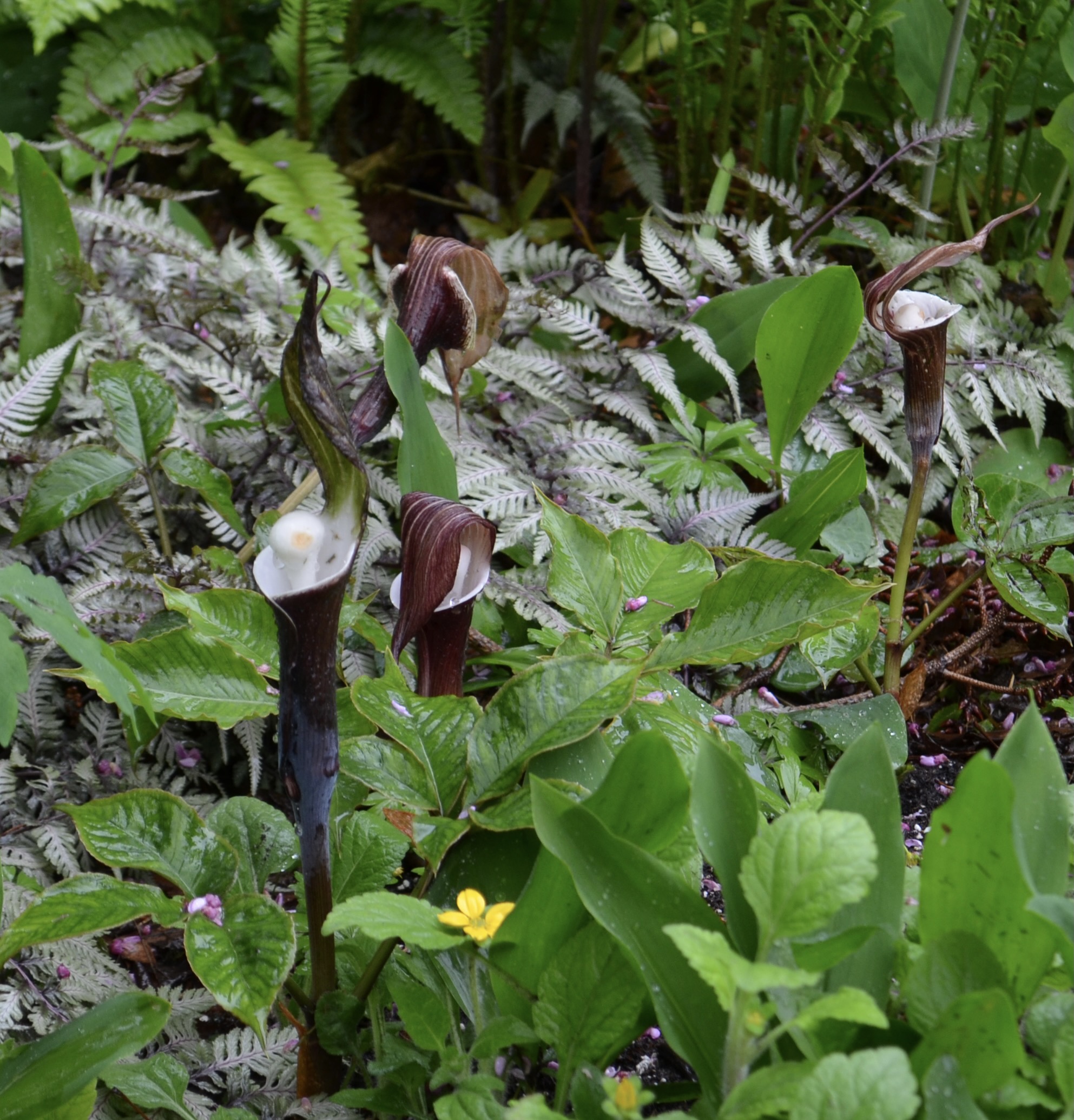I realized we were officially in the grip of pre-Halloween hysteria last week when I was fishing out my wallet to pay for some items in our local pharmacy. A woman swept past me, one hand gripped on a trailing child, the other pointing towards the back of the store. In a loud, theatrical whisper, she asked the cashier “Needing blood and fangs! This aisle?”
Halloween is fun. OK, modern Halloween is fun. I get the impression Celts and Druids took this time of the year a tad more seriously back in the day. But, hey, now we get to dress up, act silly and eat way too much cheap candy. What’s not to love? But as much as I love a good transmogrification come October 31st–my three-year-old step-granddaughter turning into a baby elephant, for instance, or a front yard tree turning into bedsheet Ghost Central–I got to thinking about how some plants have undeservedly inherited a reputation for spookiness.

I carved this pumpkin several years ago, inspired by the Minions movies. The eye is made by carving one large hole in the side of the pumpkin, propping a black jar lid up with pins to the bottom edge of the hole and lining the entire hole with a piece of white paper, secured with pins to the inside of the pumpkin.
Take pumpkins, for instance. They’re a native of North America (probably originating in Mexico about 9,000 years ago) and were a crucial food staple for eons. The practice of carving them into scary faces is attributed to Irish immigrants who, back across the pond, would carve potatoes or turnips into Jack-O’-Lanterns. Can you imagine the excitement and sheer relief that first Irish-American felt upon laying eyes on a big ol’ pumpkin after years of carving up teeny tiny tubers every Halloween?
There’s nothing wrong with taking artistic advantage of giant fruits (yep, pumpkins are not a vegetable) but now, every October, the once humble dinner staple gets thrown into the spotlight in all its spooky glory. Shortly thereafter, carved pumpkins get thrown. Period. It’s the wise pedestrian who walks carefully down a sidewalk during the first few days after Halloween in these parts. Gished pumpkin parts are a pain to scrape off the soles of your boots.
SIDE NOTE: Halloween joke!
WHAT DO YOU GET WHEN YOU DROP A PUMPKIN?
SQUASH!
The flowers of darkness
Google “black flowers” and you’ll get tons of lists and websites pointing out the best varieties of black blooms, all of which are the successful results of skilled and patient breeding. Very dark-to-black flowers rarely occur naturally. This is due primarily to the fact that pollinators are attracted to bright colours. So why would a plant naturally want to grow black flowers? Good question.
In extreme environments, such as the Arctic, black flowers can be a bonus. As we all know from wearing black during a hot, sunny day, dark colours tend to absorb heat. Flowers can take advantage of this. According to a fascinating research paper from Frontiers in Plant Science, “Warmer flowers can help insects to elevate their body temperature. Bees prefer flowers with warm nectar and this choice becomes stronger with decreasing ambient temperature. Warm flowers also provide high quality reward to pollinators compared with low temperature flowers.” So there you go.
But even when a flower is naturally black, the overall effect can be deceiving. For instance, the Arctic dwelling Dwarf Cornel (Cornus suecica) is a naturally occurring black flower although you wouldn’t know it unless you knew your flower anatomy really well. The plant’s teeny black flowers look more like the centre of the flower. Surrounding the black petals are larger white leaves that look just like petals. Check out a photo of this lovely little flower, courtesy of the University of Lapland.


There are always a variety of almost-black petunias (such as the ones above) available every year, thanks to commercial breeding.
Nursery centres sell lots of hybrid black flowers, happy to keep offering gardeners more and more choices. So what’s the appeal of far-from-natural black flowers?
I’d like to say they’re popular for the dramatic contrast they bring to a garden bed or a container planting. Some of the larger black flowers such as Iris ‘Before the storm’, Hollyhock ‘Nigra’, and Tulip “Queen of night’ have a glamour about them. But, let’s face it, black flowers have a very desirable spookiness to them just because we all know they aren’t naturally occurring. Clearly not a part of the world of bright blooms, black flowers epitomize separateness.
Naturally spooky
And then there are some plants that just look evil even though they’re perfectly unassuming. Take the Jack-in-the-pulpit (Arisaema triphyllum), see below, a native of eastern Canada and the United States. You’d think this plant would have no problem devouring baby chipmunks–for fun. But that tall, tubular maw is actually the plant’s sweetly protective flower. The striped ‘pitcher’ part or ‘pulpit’, called a spathe, sports a long, curving hood which protects the spadix (our wee ‘Jack’), an erect spike covered in tiny flowers. The hood stops the pulpit, erm, spathe from filling up with rainwater. Insects assist with pollination by flying into the spathe, attracted by the aroma and colour of the pollen within.
I’m not going to say this little nature story has a 100% happy ending. Some insects do find the spathe hard to leave and some never escape but that’s due to an unfortunate glitch in the plant’s design. This plant is absolutely non-carniverous. Eventually the plant produces bright red berries which birds and small forest mammals munch without incident.

A wild Jack-in-the-pulpit (Arisaema triphyllum) growing near our home on Ontario’s Bruce Peninsula.
Japanese cobra lilies (Arisaema sikokianum), see below, are closely related to our native Jack-in-the-pulpit but if you’ve been paying attention you’ve already figured out that Japanese cobra lilies are native to Japan. Cobra lilies have a hooded spathe sheltering a spadix, just like our Jack-in-the-pulpits, but the cobra lily has a ghostly white spadix. Seriously, the weird club-like shape to the spadix does a pretty good impersonation of a wee Caspar the Friendly Ghost. In my opinion, they are about as other-wordly looking as a plant can get. But, like their North American cousins, cobra lilies play well with other plants and critters in the garden, being absolutely non-carniverous and looking particularly gorgeous paired with Japanese painted fern (Athyrium niponicum), as seen below.


Japanese cobra lilies (Arisaema sikokianum) in a southwestern Ontario garden with Japanese Painted Fern.
If you’d like to read more about spooky plants and other weird (yet natural!) things that can grow in your garden, check out my post Killer plants versus The Blob. Here’s an excerpt, about someone who had a real life encounter with a blob in their backyard:
They found a mass pulsating in the grass. News reports on the discovery claimed that a ‘new life form’ had been found. Actually, it was a very old form of life known as a plasmodial slime mold. The blob was unusually large at more than 14 inches in diameter. Not quite the size of the one Steve McQueen battled but, still, nothing you’d want to step on with your bare feet, either.
Kinda both a fungi and an animal, a slime mold can live as independent cells but, when the environment isn’t to their liking, they can band together, literally, to form a single, erm, thing (sometimes called a collective slug) and proceed to “ooze” towards whatever it is it/they need such as more light or better food. They can move at a rate of about one inch per day.
Now that’s spooky!

This year’s carved pumpkin was inspired by the emoji I tend to use most often.
Have a happy and safe Halloween, everyone!




Pingback: Berry weird | Ministry of the fence
I love that first pumpkin! So great… Also, interesting to learn about the black flowers. I had no idea, but I guess that all makes sense. I know the “petals” of Cornus are bracts, but for those little C. suecia, I always tend to forget. They are so cute!
LikeLiked by 1 person